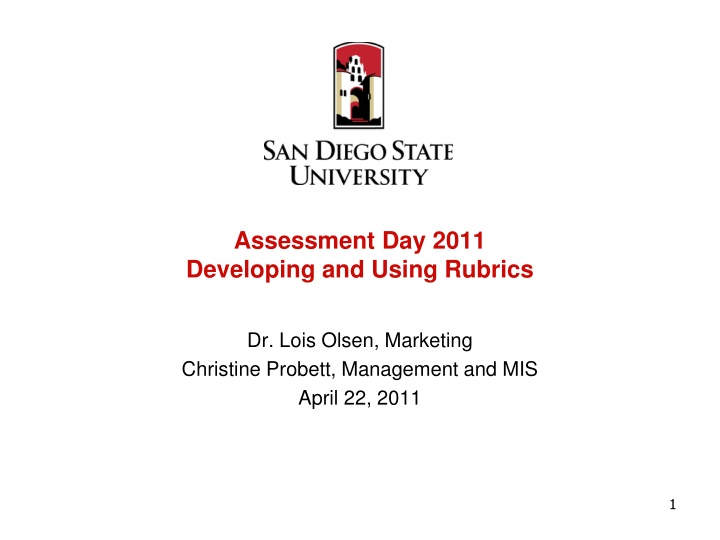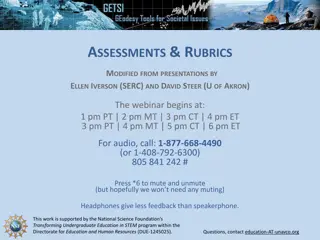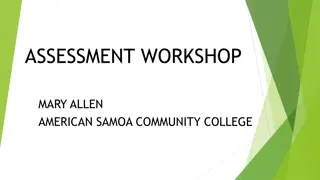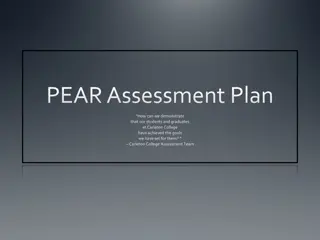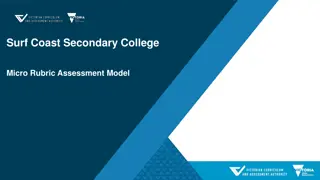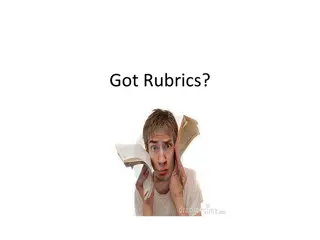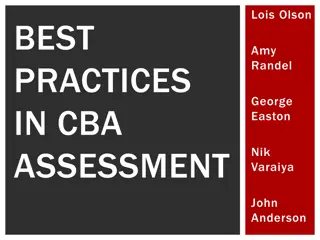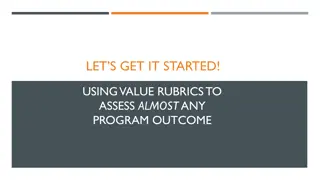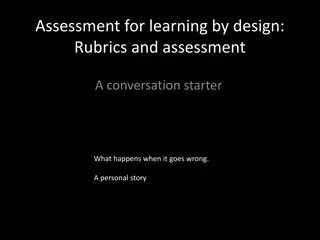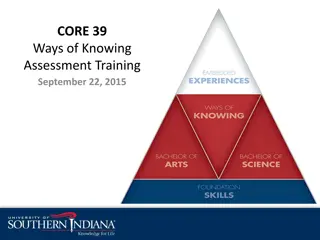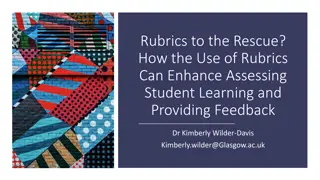Assessment Day 2011 Developing and Using Rubrics
Speaker profiles of Dr. Lois Olsen and Christine Probett discuss their experience and strategies in utilizing rubrics for assessing student assignments in marketing courses. The provided rubric creation hints offer valuable insights into setting assignment goals, conducting market analysis, and evaluating entry strategies.
Download Presentation

Please find below an Image/Link to download the presentation.
The content on the website is provided AS IS for your information and personal use only. It may not be sold, licensed, or shared on other websites without obtaining consent from the author.If you encounter any issues during the download, it is possible that the publisher has removed the file from their server.
You are allowed to download the files provided on this website for personal or commercial use, subject to the condition that they are used lawfully. All files are the property of their respective owners.
The content on the website is provided AS IS for your information and personal use only. It may not be sold, licensed, or shared on other websites without obtaining consent from the author.
E N D
Presentation Transcript
Assessment Day 2011 Developing and Using Rubrics Dr. Lois Olsen, Marketing Christine Probett, Management and MIS April 22, 2011 1
Speaker Profile/Rubric Approach Lois Olson Christine Probett Lecturer, teaching 4 years Teaching Experience Courses Taught Instructor, teaching 34 years Marketing, Global Marketing, Consumer Behavior, BA 404, Marketing Strategy Using rubrics for 4 years Organizational Behavior, HR Mgmt, Operations Mgmt, Int l Business Strategy & Integration Using rubrics for 3 years Rubric Experience Rubric Approach Rubric Applications Modify CBA Rubric with specific assignment goals For group assignments: Written: HBR case 15%. Oral: Ethical Dilemma 5%, Case Study analysis 20% Start with Blank Sheet and create custom Rubric Typically for assignments worth 15+% course grade: Market analysis 40%, etc. 3-2 2 2
Rubric Creation Hints: Lois 1 2 3 4 5 A. Goals and Objectives* Country selection and entry mode Country well justified and complete explanation of entry strategy Begin with what is expected In order to get a B. Missing SW - match, goals Matches firm s ability w/ entry mode, country; attainable goals well detailed Missing B. Market Analysis* 1. Mrkt. Structure definition Fit to Oppt ys , Protection agst. Threats 2. Current Competitive Mkt. for product chosen Econ/dem/tech/ infrastr. well de- fined to identify Oppt ys and Threats to firm Missing Good descript. of exist. consmr. solution to problem, relative mkt and compt. strategy Missing 3-3 3 3
Rubric Creation Hints: Lois 1 2 3 4 5 A. Goals and Objectives* Country selection and entry mode Country well explained, good description of entry strategy Country well justified and complete explanation of entry strategy Missing Explains why country choice, entry mode are selected; major goals stated SW - match, goals Matches firm s ability w/ entry mode, country; attainable goals well detailed Drop down to a C level Element by element. Missing B. Market Analysis* 1. Mrkt. Structure definition Fit to Oppt ys , Protection agst. Threats Econ/dem/tech/ infrastr. de- fined reasonably but not fully as to Oppt ys and Threats to firm Reasonable description of competing solutions and their mktg. Econ/dem/tech/ infrastr. well de- fined to identify Oppt ys and Threats to firm Missing Good descript. of exist. consmr. solution to problem, relative mkt and compt. strategy 2. Current Competitive Mkt. for product chosen Missing 3-4 4 4
Rubric Creation Hints: Lois 1 2 3 4 5 A. Goals and Objectives* Country selection and entry mode Some rationale for country selected, choice of entry strategy weak Country well explained, good description of entry strategy Country well justified and complete explanation of entry strategy Missing Provides some rationale for fit between firm, country and goals Explains why country choice, entry mode are selected; major goals stated SW - match, goals Matches firm s ability w/ entry mode, country; attainable goals well detailed Identify what is really weak but still passing on each Element. Missing B. Market Analysis* 1. Mrkt. Structure definition Fit to Oppt ys , Protection agst. Threats Weak definition of the current mrkt . structure, Oppty s.Threats ambiguous Econ/dem/tech/ infrastr. de- fined reasonably but not fully as to Oppt ys and Threats to firm Reasonable description of competing solutions and their mktg. Econ/dem/tech/ infrastr. well de- fined to identify Oppt ys and Threats to firm Missing Simple description of existing market, competing solutions Good descript. of exist. consmr. solution to problem, relative mkt and compt. strategy 2. Current Competitive Mkt. for product chosen Missing 3-5 5 5
Rubric Creation Hints: Lois 1 2 3 4 5 A. Goals and Objectives* Country selection and entry mode Some rationale for country selected, choice of entry strategy weak Country well explained, good description of entry strategy Country well justified and complete explanation of entry strategy Country very well justified over other options, fully detailed entry strategy Leaves no doubt firm and country are optimal fit and goals well be achieved Missing Provides some rationale for fit between firm, country and goals Explains why country choice, entry mode are selected; major goals stated SW - match, goals Matches firm s ability w/ entry mode, country; attainable goals well detailed Missing Fill the most Difficult value, that required to get an A. B. Market Analysis* 1. Mrkt. Structure definition Fit to Oppt ys , Protection agst. Threats Weak definition of the current mrkt . structure, Oppty s.Threats ambiguous Econ/dem/tech/ infrastr. de- fined reasonably but not fully as to Oppt ys and Threats to firm Reasonable description of competing solutions and their mktg. Econ/dem/tech/ infrastr. well de- fined to identify Oppt ys and Threats to firm Very detailed explanation of the market structure to offer Oppty s /Threat Missing Simple description of existing market, competing solutions Good descript. of exist. consmr. solution to problem, relative mkt and compt. strategy Reader could walk into market and fully know currnt. solutions competition, no questions 2. Current Competitive Mkt. for product chosen Missing 3-6 6 6
Rubric Creation Hints: Christine Ethical Dilemma Presentation Rubric Below Expectations (0-1 Points) Meets Expectations (2-3 Points) Exceeds Expectations (4-5 Points) Provide clear overview of company(s) and issues. Incorporate course concepts and topics to address issues. Respond to questions and/or recommendations of assignment. Clear opening and closing statements. Introduction of team members. Catches audience s interest, provides overview/conclusion. Follows logical sequence, stays focused, good explanations. Effective time management and strong transitions. Strong mental take away for audience. Enthusiastic and engaging. Speaks clearly and loudly enough at a comfortable pace. Exudes confidence and interest. No grammatical or pronunciation errors. Presentation appears conversational, extemporaneous, and natural. Body language used effectively to maintain audience s interest. Body language reflects presenter s reaction to, and empathy with, the audience. Gestures match verbal content, are comfortable and relaxed, seem spontaneous. Meets time target (7-12 minutes). Score Weight TOTAL POINTS x Assignment Specifics [20%] Limited overview of company(s) and issues. No link to course concepts or topics to address issues. Did not address questions and/or recommendations of assignment. No opening and/or closing statements or irrelevant opening/closing statements. Loses focus more than once. Does not manage time effectively. No logical sequence of information. Mechanistic. Provide some overview of company(s) and issues. Links some course concepts and topics to address issues. Some response to questions and/or recommendations of assignment. No introduction of team members. Offers some type of opening and closing statements. Follows logical sequence but structure could be better. May need more elaboration on one or more points. Adequate time management, but could be stronger. Limited transitions. Easily understood. Speaks at appropriate pace. Mostly clear and natural, some ums or ahs . Some awkward pauses or halting delivery but mostly clear and natural. Could display greater enthusiasm. x 4 Organization & Flow [15%] x 3 x Voice Quality & Pace [15%] Mumbles, mispronounces words, grammatical errors, excessive ums or ahs . Difficult to understand. Speaks too quietly or too loudly. Speaks too fast or too slow. Loses train of thought, tentative. Lacks enthusiasm. Demonstrates distracting mannerisms which may include bad posture,shifting body/feet, too much/too little hand movement. Cross/uncross legs. Turns head/body away from audience. Seems fearful/very nervous. Significantly under (<5 minutes) or over (>14 minutes) time target x 3 x Mannerisms & Body Language [15%] Some distracting mannerisms. Acceptable posture. Body language mostly demonstrates comfort in interacting with audience but occasional instances of discomfort may be communicated. Seems natural for the most part. Too far away from screen Moderately under (5-6 minutes) or over (12-14 minutes) time target x 3 x Timing (7 - 12 minutes) [15%] x 3 x Rapport with Audience [10%] Does not connect with audience. Little to no eye contact. Reads. Relies heavily on slides and/or notes. Notes on large piece of paper. Attempts to cover too many slides or lingers too long on too few slides. Slides are difficult to read, too busy or many typos. Slides over/under-crowded. Team member names not listed. No page numbers. Inconsistent format. Tries to maintain eye contact most of the time but instances may be fleeting in length. Scans the room. Some reliance on notes or slides. Notes on cards. Too many/ few slides. Some difficult to read, some typos, some over/under crowded. Team member names listed but not in alphabetical order. No page numbers. Some variation of font, bullet, style, etc. Genuinely connects with audience. Maintains eye contact throughout. Appropriate use of notes and slides. x 2 x Use of Media [10%] Slides effortlessly enhance speech. Appropriate number of slides. Nice, consistent format, slides are clean and easy to read. Team member names listed in alphabetical order. Page numbers on each chart. x 2 x Total Score ______% Steps: 1. Establish key elements/outcomes of assignment 2. Eliminate unimportant elements of CBA Rubric, add important elements of assignment 3. Assign weighting total of all elements adds up to 100% 4. Rubric is filled out electronically (underline scored areas) 5. Total score is base score for all group members, potentially adjusted up/down based on peer evaluation input 3-7 7 7
Rubric Pros and Cons Lois Olson Christine Probett Grading is so fast and so much more fair Students know what they have to do Students think more seriously about complaining Limited space for detailed feedback and comments Limited space for detailed feedback and comments Plan ahead Instructor reluctant to change assignment have to change rubric Makes grading easier and more consistent Grades better understood & accepted limited/no push-back Assignment expectations are clear Overall student performance is improving! Assignment must be well planned prior to creation of rubric and grading of assignment Pros Cons 3-8 8 8
